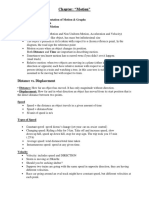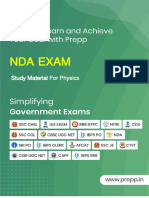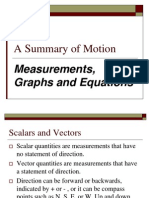0% found this document useful (0 votes)
21 views2 pagesMotion Full Notes Class9
Chapter 8 of Class 9 Science covers the concept of motion, defining it as the change in position of an object over time, and introduces types of motion such as rectilinear, circular, periodic, and rotational. It distinguishes between distance (scalar) and displacement (vector), and explains speed, velocity, and acceleration, including their graphical representations. The chapter also presents equations of uniformly accelerated motion and discusses uniform circular motion, emphasizing the importance of reference points and the differences between scalar and vector quantities.
Uploaded by
mrspanishbonCopyright
© © All Rights Reserved
We take content rights seriously. If you suspect this is your content, claim it here.
Available Formats
Download as PDF, TXT or read online on Scribd
0% found this document useful (0 votes)
21 views2 pagesMotion Full Notes Class9
Chapter 8 of Class 9 Science covers the concept of motion, defining it as the change in position of an object over time, and introduces types of motion such as rectilinear, circular, periodic, and rotational. It distinguishes between distance (scalar) and displacement (vector), and explains speed, velocity, and acceleration, including their graphical representations. The chapter also presents equations of uniformly accelerated motion and discusses uniform circular motion, emphasizing the importance of reference points and the differences between scalar and vector quantities.
Uploaded by
mrspanishbonCopyright
© © All Rights Reserved
We take content rights seriously. If you suspect this is your content, claim it here.
Available Formats
Download as PDF, TXT or read online on Scribd
/ 2
























































